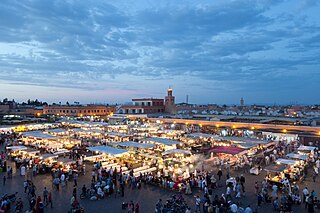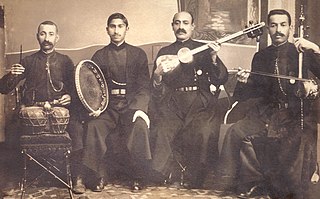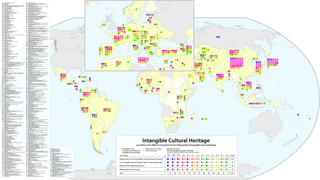
Cultural diversity is the quality of diverse or different cultures, as opposed to monoculture. It has a variety of meanings in different contexts, sometimes applying to cultural artifacts like music recordings or art works in museums, and sometimes applying to the variety of human cultures or traditions in a specific region, or in the world as a whole. It can also refer to the inclusion of different cultural perspectives in an organization or society.

Ifugao, officially the Province of Ifugao, is a landlocked province of the Philippines in the Cordillera Administrative Region in Luzon. Its capital is Lagawe and it borders Benguet to the west, Mountain Province to the north, Isabela to the east, and Nueva Vizcaya to the south.

Jemaa el-Fnaa is a square and market place in Marrakesh's medina quarter. It remains the main square of Marrakesh, used by locals and tourists.
A Living Human Treasure is, according to UNESCO, a person who possesses to a high degree the knowledge and skills required for performing or re-creating specific elements of the intangible cultural heritage. This title or a form of it is awarded by the nation's government to a person who is regarded as a national treasure while still alive. The title is also known as Living National Treasure.
An intangible cultural heritage (ICH) is a practice, representation, expression, knowledge, or skill considered by UNESCO to be part of a place's cultural heritage. Buildings, historic places, monuments, and artifacts are cultural property. Intangible heritage consists of nonphysical intellectual wealth, such as folklore, customs, beliefs, traditions, knowledge, and language. Intangible cultural heritage is considered by member states of UNESCO in relation to the tangible World Heritage focusing on intangible aspects of culture. In 2001, UNESCO made a survey among States and NGOs to try to agree on a definition, and the Convention for the Safeguarding of the Intangible Cultural Heritage was drafted in 2003 for its protection and promotion.

Mugham or Mughamat is one of the many classical compositions from Azerbaijan, contrasting with tasnif and ashik.

San Basilio de Palenque or Palenque de San Basilio, often referred to by the locals simply as Palenke, is a Palenque village and corregimiento in the Municipality of Mahates, Bolivar in northern Colombia. Palenque was the first free African town in the Americas, and in 2005 was declared a Masterpiece of the Oral and Intangible Heritage of Humanity by UNESCO.

The Intangible Cultural Heritage are aspects of intangible culture that the government of South Korea has officially designated for preservation in accordance with the 1962 Cultural Property Protection Law. They are proclaimed and maintained by South Korea's Cultural Heritage Administration.

UNESCO established its Lists of Intangible Cultural Heritage with the aim of ensuring better protection of important intangible cultural heritages worldwide and the awareness of their significance. This list is published by the Intergovernmental Committee for the Safeguarding of Intangible Cultural Heritage, the members of which are elected by State Parties meeting in a General Assembly. Through a compendium of the different oral and intangible treasures of humankind worldwide, the programme aims to draw attention to the importance of safeguarding intangible heritage, which UNESCO has identified as an essential component and as a repository of cultural diversity and of creative expression.

The Convention for the Safeguarding of the Intangible Cultural Heritage is a UNESCO treaty adopted by the UNESCO General Conference on 17 October 2003.
Ichpedia is an online encyclopedia for the intangible cultural heritage in Korea and international arenas. It was created by a group of scholars and practitioners with the support of the Cultural Heritage Administration of the Republic of Korea. The ultimate goal is to enhance the significance of traditional cultures and cultural diversities.
Mounir Bouchenaki is an Algerian archaeologist and incumbent Director of the Arab Regional Centre for World Heritage. He was Director-General of ICCROM from 2006 to 2011, UNESCO's Assistant Director General for Culture (2000-2006), Director of the World Heritage Centre (1998-2000), Director of UNESCO's Cultural Heritage Division (1990-2000). In January 2011, he was named honorary special adviser of UNESCO Director-General Irina Bokova and of ICCROM Director-General.
Intangible cultural heritage (ICH) includes traditions and living expressions that are passed down from generation to generation within a particular community.
The Eshuva are the Harákmbut-language sung prayers of Peru's Huachipaire people. They are sung as an expression of Huachipaire religious myths to summon nature spirits, to help alleviate illness or promote well-being, as part of traditional ceremonies, and during the initiation of the new Eshuva singers. Eshuva songs are performed without musical accompaniment. Since they are sung only in the Harákmbut language, they help safeguard the Huachipaire people's language, values, and worldview.
Cultural expressions are creative manifestations of the cultural identities of their authors. They are treated in the international legal system in terms of cultural rights, intellectual property law and international trade.

UNESCO established its Lists of Intangible Cultural Heritage with the aim of ensuring better protection of important intangible cultural heritages worldwide and the awareness of their significance. Elements inscribed in the lists are deemed as significant bastions of humanity's intangible heritage, the highest honour for intangible heritage in the world stage. To date, there are 6 intangible cultural heritages of Cambodia have been inscribed on the list. Four elements are on the Representative List of Intangible Cultural Heritage of Humanity, and two elements are on the List of Intangible Cultural Heritage in Need of Urgent Safeguarding.













